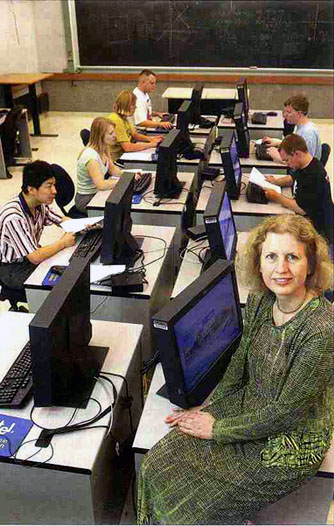Professor Hambrusch in Indiana Business Magazine
08-12-2004

You may have seen a familiar face in the last issue of Indiana Business magazine. Professor Susanne Hambrusch graced the pages of Indiana Business magazine's July 2004 issue. The magazine's cover story featured the "Technology Stars" of Techpoint's MIRA Awards. Photos of Professor Hambrusch were taken at the Computer Science building and the magazine provided a vignette of her background and accomplishments which led her to win the 2004 Techpoint MIRA Award for Educator. Please see the Indiana Business magazine article below.
Education Award
Susanne Hambrusch, Purdue University, West Lafayette Living in a casual campus atmosphere, Susanne Hambrusch says it's not often that she gets the chance to dress up. So as the recipient of the Mira Education Award, the Purdue professor and computer science department head–along with her supportive colleagues–took full advantage of the "black-tie optional" awards ceremony to savor the moment. A native of Austria, Hambrusch earned a master's in computer science from the Technical University of Vienna, and a Ph.D. in computer science from Pennsylvania State, where she met her husband. As Indiana's luck would have it, both were offered jobs at Purdue in 1982. She worked through the roles of assistant professor and professor where she focused on such heady things as parallel and distributed computation, data management in wireless environments and analysis of algorithms.

She moved on to associate department head and was appointed department head in 2002. "When you are faculty, you look out for your own research group and your own students," she says. "Now I'm concerned with everything. As a professor, you can only complain. Now I can say, ‘Let's try it.'" One of the things she's trying is a course where students use tablet PCs–essentially a giant PDA nearly the size of a laptop–where they write on the screen like a big sheet of paper. Juniors and seniors in the class of 25 work in teams to create new software tools for the tablet interface. To get the program started, Intel and Microsoft were persuaded to provide the tablets.
Hambrusch has long been a supporter of women in science and engineering. She was a critical facilitator for the establishment of the Computer Science Women's Network at Purdue, and an initial advisor and participant in the Women in Science Mentoring Program. She's disappointed that only 8 to 9 percent of undergraduate computer science students are women, and that the percentage has dropped in the last few years, even as total enrollment has grown. "This is everywhere," she explains, not just at Purdue. But she's pleased that women make up 20 percent of graduate enrollment. "We control graduate school admission. It's much easier to say, ‘This is the student we want.'"